
In botany, a bract is a modified or specialized leaf, especially one associated with a reproductive structure such as a flower, inflorescence axis or cone scale. Bracts are usually different from foliage leaves. They may be smaller, larger, or of a different color, shape, or texture. Typically, they also look different from the parts of the flower, such as the petals or sepals. A plant having bracts is referred to as bracteate or bracteolate, while one that lacks them is referred to as ebracteate and ebracteolate, without bracts.
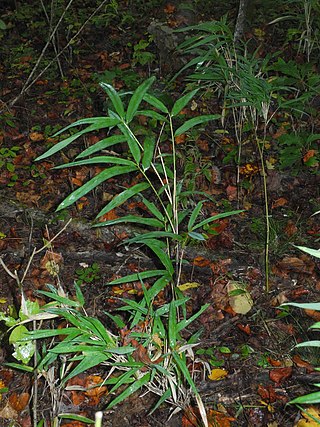
Arundinaria appalachiana, commonly known as hill cane, is a woody bamboo native to the Appalachian Mountains in the southeastern United States. The plant was elevated to the species level in 2006 based on new morphological and genetic information and was previously treated as a variety of Arundinaria tecta. The shortest member of its genus, hill cane ranges from 0.4–1.8 meter tall with a habit ranging from diffuse to pluri-caespitose. It is one of only three temperate species of bamboo native to North America. Hill cane is common on dry to mesic sites on upland slopes, bluffs and ridges in oak-hickory forests, which distinguishes it from other species in the genus: Arundinaria gigantea typically appears along perennial streams, while Arundinaria tecta is found in swamps and other very wet areas.

Ephedra aspera is a species of Ephedra known by the common names rough jointfir, boundary ephedra, and pitamoreal. It is native to the southwestern United States from California to Texas and parts of northern Mexico as far south as Zacatecas. It is a resident of varied woodland and scrub plant communities.
Plectocomiopsis is a dioecious genus of flowering plant in the palm family found in Indochina, Malaysia, Borneo and Sumatra. Hapaxanthic and armed with spines, they are a climbing rattan, closely related to the Myrialepis palms. The name is Greek for "similar to Plectocomia", another close relative.
Pogonotium was a dioecious genus of flowering plant in the palm family found in Malaysia and Borneo. Its species are now included within the genus Calamus. Its close relatives are climbing rattans and while partially armed with climbing apparatus, its habit is sprawling and leaning but not effective climbing. The reduced inflorescence nestled between the auricles is unusual and distinguishes it from similar relatives like Calamus, Daemonorops and Ceratolobus. The name is Greek meaning "bearded".
Eleocharis montevidensis is a species of spikesedge known by the common name sand spikerush. It is a widespread coastal plant native to the Americas. It grows in moist, sandy spots in many habitat types, including lakes, riverbanks, wet meadows, and springs. It has a disjunct distribution, in North America and South America.

Polyarrhena is a genus of low, branching shrublets that is assigned to the daisy family. Its stems are alternately and densely set with entire or somewhat toothed leaves. Like in almost all Asteraceae, the individual flowers are 5-merous, small and clustered in typical heads, and which are surrounded by an involucre of in this case three whorls of bracts. In Polyarrhena, the centre of the head is taken by yellow disc florets, and is surrounded by one single whorl of white ligulate florets that have a pinkish-purple wash on the underside. These florets sit on a common base and are not individually subtended by a bract. The species occur in the Cape Floristic Region. Polyarrhena reflexa has long been cultivated as an ornamental and is often known under its synonym Aster reflexum.

Dendrocalamus strictus is a bamboo species belonging to the Dendrocalamus genus. The culms (stems) are often solid. Common names include male bamboo, solid bamboo, and Calcutta bamboo.

Bambusa bambos, the giant thorny bamboo, Indian thorny bamboo, spiny bamboo, or thorny bamboo, is a species of clumping bamboo native to southern Asia. It is also naturalized in Seychelles, Central America, West Indies, Java, Malaysia, Maluku, and the Philippines.

Digitaria insularis is a species of grass commonly known as sourgrass. It is native to Central and South America and the southern parts of the United States and has been introduced into other parts of the world. It was first described by the German botanist Friedrich Karl Georg Fedde in 1904.
Dendrocalamus longispathus, the long-sheath bamboo, is a bamboo species which grows up to 20 m tall. It is native to Bangladesh, Myanmar, and Thailand. It has now become an exotic species all over the South Asia.

Machaerina juncea, commonly known as bare twig-rush or tussock swamp twig rush, is a sedge in the sedge family, Cyperaceae, that is native to Australia, New Zealand, and New Caledonia.
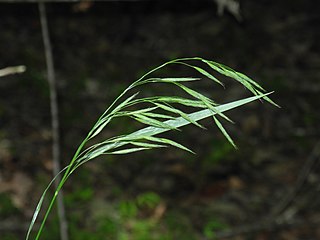
Bromus nottowayanus, the Nottoway Valley brome or satin brome, is a brome grass native to North America. The specific epithet nottowayanus refers to the Nottoway Valley. The grass has a diploid number of 14.

Schoenus arenicola is a species of sedge endemic to the south-west coast of South Africa.
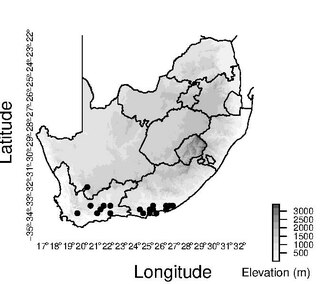
Schoenus megacarpus is a species of sedge endemic to the south-central region of South Africa.
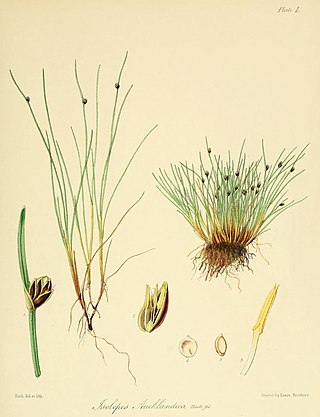
Isolepis aucklandica is a species of flowering plant in the Cyperaceae family. It is native to New Zealand, Australia, Argentina, Peru, Colombia, Ecuador, Macquarie Island, the French Southern Territories of Saint Paul and Amsterdam Islands, and New Guinea.

Rottboellia cochinchinensis is a species of grass known by the common names Itchgrass,Raoul grass, corngrass, Kokoma grass, Guinea-fowl grass, jointed grass, Shamwa grass and Kelly grass. It is a tall, tufted annual grass whose stems (culms) grow up to 3 metres in height with leaf-blades of up to 45 centimetres in length. The species flowers at the apex of culms in the form of spike-like racemes composed of paired spikelets. The common name Itchgrass comes from the bristly (hispid) leaf-sheath which can be irritating to the skin.
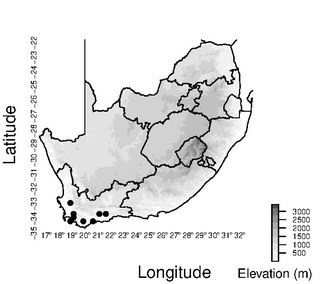
Schoenus brunnescens is a species of sedge endemic to the Western Cape Province of South Africa.

Schoenus crinitus is a species of sedge endemic to the Worcester region of the Western Cape Province of South Africa.
Rhynchospora gracillima is a widespread species of sedge.














